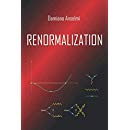Infinite reduction of couplings
The infinite reduction of couplings is a tool to consistently renormalize a wide class of non-renormalizable theories with a reduced, eventually finite, set of independent couplings, and classify the non-renormalizable interactions. Several properties of the reduction of couplings, both in renormalizable and non-renormalizable theories, can be better appreciated working at the regularized level, using the dimensional-regularization technique. We show that, when suitable invertibility conditions are fulfilled, the reduction follows uniquely from the requirement that both the bare and renormalized reduction relations be analytic in $\varepsilon=D-d$, where $D$ and $d$ are the physical and continued spacetime dimensions, respectively. In practice, physically independent interactions are distinguished by relatively non-integer powers of epsilon. We discuss the main physical and mathematical properties of this criterion for the reduction and compare it with other equivalent criteria. The leading-log approximation is solved explicitly and contains sufficient information for the existence and uniqueness of the reduction to all orders.
J.High Energy Phys. 01 (2006) 077 | DOI: 10.1088/1126-6708/2006/01/077
arXiv: hep-th/0509196
I study the problem of renormalizing a non-renormalizable theory with a reduced, eventually finite, set of independent couplings. The idea is to look for special relations that express the coefficients of the irrelevant terms as unique functions of a reduced set of independent couplings $\lambda$, such that the divergences are removed by means of field redefinitions plus renormalization constants for the $\lambda$s. I consider non-renormalizable theories whose renormalizable subsector $R$ is interacting and does not contain relevant parameters. The “infinite” reduction is determined by $i$) perturbative meromorphy around the free-field limit of $R$, or $ii$) analyticity around the interacting fixed point of $R$. In general, prescriptions $i$) and $ii$) mutually exclude each other. When the reduction is formulated using $i$), the number of independent couplings remains finite or slowly grows together with the order of the expansion. The growth is slow in the sense that a reasonably small set of parameters is sufficient to make predictions up to very high orders. Instead, in case $ii$) the number of couplings generically remains finite. The infinite reduction is a tool to classify the irrelevant interactions and address the problem of their physical selection.
JHEP 0508 (2005) 029 | DOI: 10.1088/1126-6708/2005/08/029
arXiv:hep-th/0503131
Certain power-counting non-renormalizable theories, including the most general self-interacting scalar fields in four and three dimensions and fermions in two dimensions, have a simplified renormalization structure. For example, in four-dimensional scalar theories, $2n$ derivatives of the fields, $n>1$, do not appear before the nth loop. A new kind of expansion can be defined to treat functions of the fields (but not of their derivatives) non-perturbatively. I study the conditions under which these theories can be consistently renormalized with a reduced, eventually finite, set of independent couplings. I find that in common models the number of couplings sporadically grows together with the order of the expansion, but the growth is slow and a reasonably small number of couplings is sufficient to make predictions up to very high orders. Various examples are solved explicitly at one and two loops.
JHEP 0507 (2005) 077 | DOI: 10.1088/1126-6708/2005/07/077
arXiv:hep-th/0502237
I show that under certain conditions it is possible to define consistent irrelevant deformations of interacting conformal field theories. The deformations are finite or have a unique running scale (“quasi-finite”). They are made of an infinite number of lagrangian terms and a finite number of independent parameters that renormalize coherently. The coefficients of the irrelevant terms are determined imposing that the beta functions of the dimensionless combinations of couplings vanish (“quasi-finiteness equations”). The expansion in powers of the energy is meaningful for energies much smaller than an effective Planck mass. Multiple deformations can be considered also. I study the general conditions to have non-trivial solutions. As an example, I construct the Pauli deformation of the IR fixed point of massless non-Abelian Yang-Mills theory with $N_c$ colors and $N_f \lesssim 11N_c/2$ flavors and compute the couplings of the term $F^3$ and the four-fermion vertices. Another interesting application is the construction of finite chiral irrelevant deformations of $N=2$ and $N=4$ superconformal field theories. The results of this paper suggest that power-counting non-renormalizable theories might play a role in the description of fundamental physics.
JHEP 0310 (2003) 045 | DOI: 10.1088/1126-6708/2003/10/045
arXiv:hep-th/0309251
As it stands, quantum gravity coupled with matter in three spacetime dimensions is not finite. In this paper I show that an algorithmic procedure that makes it finite exists, under certain conditions. To achieve this result, gravity is coupled with an interacting conformal field theory $C$. The Newton constant and the marginal parameters of $C$ are taken as independent couplings. The values of the other irrelevant couplings are determined iteratively in the loop- and energy-expansions, imposing that their beta functions vanish. The finiteness equations are solvable thanks to the following properties: the beta functions of the irrelevant couplings have a simple structure; the irrelevant terms made with the Riemann tensor can be reabsorbed by means of field redefinitions; the other irrelevant terms have, generically, non-vanishing anomalous dimensions. The perturbative expansion is governed by an effective Planck mass that takes care of the interactions in the matter sector. As an example, I study gravity coupled with Chern-Simons $U(1)$ gauge theory with massless fermions, solve the finiteness equations and determine the four-fermion couplings to two-loop order. The construction of this paper does not immediately apply to four-dimensional quantum gravity.
Nucl.Phys. B687 (2004) 124-142 | DOI: 10.1016/j.nuclphysb.2004.03.024
arXiv:hep-th/0309250

 Quantum Gravity
Quantum Gravity 


